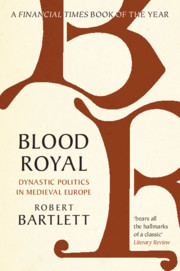Book contents
- Blood Royal
- The James Lydon Lectures in Medieval History and Culture
- Blood Royal
- Copyright page
- Dedication
- Contents
- Figures
- Preface and Acknowledgements
- Abbreviations
- Introduction Royal Families
- Part I The Life Cycle
- Part II A Sense of Dynasty
- Chapter 8 Names and Numbering
- Chapter 9 Saints, Images, Heraldry, Family Trees
- Chapter 10 Responses to Dynastic Uncertainty: Prophecy and Astrology
- Chapter 11 Pretenders and Returners: Dynastic Imposters in the Middle Ages
- Chapter 12 New Families and New Kingdoms
- Chapter 13 Dynasties and the Non-Dynastic World
- Conclusion
- Book part
- Notes
- Bibliography of Works Cited
- Index
Chapter 12 - New Families and New Kingdoms
from Part II - A Sense of Dynasty
Published online by Cambridge University Press: 09 July 2020
- Blood Royal
- The James Lydon Lectures in Medieval History and Culture
- Blood Royal
- Copyright page
- Dedication
- Contents
- Figures
- Preface and Acknowledgements
- Abbreviations
- Introduction Royal Families
- Part I The Life Cycle
- Part II A Sense of Dynasty
- Chapter 8 Names and Numbering
- Chapter 9 Saints, Images, Heraldry, Family Trees
- Chapter 10 Responses to Dynastic Uncertainty: Prophecy and Astrology
- Chapter 11 Pretenders and Returners: Dynastic Imposters in the Middle Ages
- Chapter 12 New Families and New Kingdoms
- Chapter 13 Dynasties and the Non-Dynastic World
- Conclusion
- Book part
- Notes
- Bibliography of Works Cited
- Index
Summary
This chapter looks at “new men” who created ruling dynasties, beginning with the foundation legends of the Piasts of Poland and Premyslids of Bohemia and moving on to Adam of Dryburgh ’s portrayal of the roots of the major dynasties of his own day. Dynasties that came to power through usurpation, such as the Carolingians and Capetians, sought to stress or fabricate biological links with the previous dynasty, just as the marriage of Henry I of England and his queen Edith/Matilda could be seen as uniting the blood of the Wessex and Norman kings. New dynasties often meant exclusion of members of old dynasties, and two notable examples of such excluded dynasts, Charles of Lorraine and Edgar Atheling, are discussed. The most remarkable new dynasties were those that founded new kingdoms, such as the Norman kingdom of Sicily.
- Type
- Chapter
- Information
- Blood RoyalDynastic Politics in Medieval Europe, pp. 379 - 396Publisher: Cambridge University PressPrint publication year: 2020

